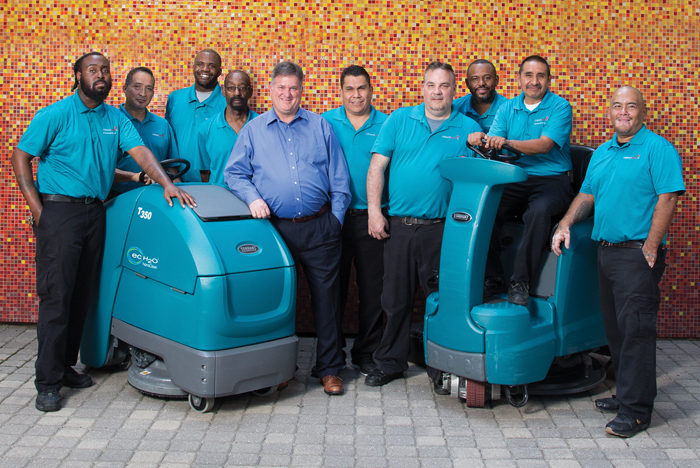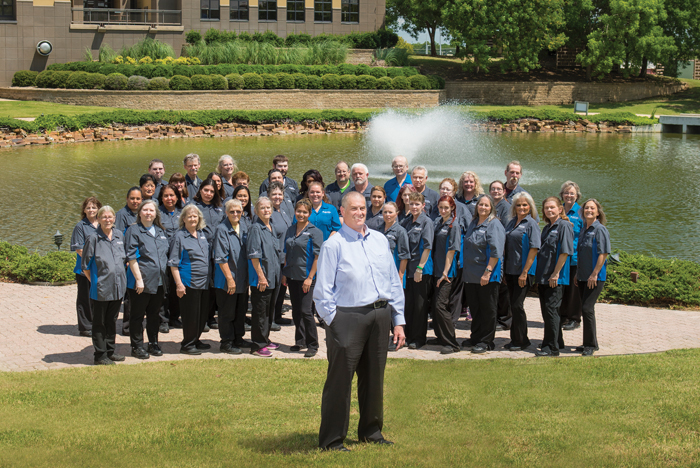
Photo by Karen Campbell
In the war on germs, hand hygiene is one of the greatest weapons in any hospital’s arsenal. And with a hand-hygiene compliance rate of 91 percent, it’s apparent that the environmental services (ES) department at Children’s Medical Center Dallas is armed with highly effective tools for preventing health care-associated infections (HAIs). One method, according to ES Director Randall Manno, CHESP, T-CHEST, T-CSCT, is something of a secret weapon.
“Hand hygiene is monitored through our ‘secret shopper program,’” says Manno, who supervises 200 employees in the hospital’s ES department. “We have dedicated personnel who watch hospital staff going in and out of certain rooms, monitoring the hand-washing process.”
ES staff are trained in the AIDET [Acknowledge, Introduce, Duration, Explanation, Thanks] protocol, in which they enter patient rooms, tell them they are disinfecting their hands and repeat the process before leaving the room — again in front of the patients. While not every room cleaning in the 490-bed hospital can be monitored, Manno’s team conducts nine audits a month and then crunches the numbers to determine the hand-hygiene rate. Results are discussed at departmental meetings without identifying employees. And hand hygiene is a goal tied to every staff member’s performance evaluation, including Manno’s.
“Our hand-hygiene program is successful because it requires the same level of participation from our technicians as any of our clinical providers and, in some cases, more,” Manno says.
The protocol not only reinforces the routine for team members, but also is a big factor in bolstering patient satisfaction and HCAHPS scores, both of which are on the upswing. Currently, patient satisfaction is at 68 percent — an 8 percent increase since 2015. HCAHPS scores increased from an average of 69.6 in 2015 to a year-to-date average of 72.8 in 2018. The national average is 72.2; the Texas state average is 72.3.
Such results helped Children’s Medical Center Dallas to earn the Association for the Health Care Environment’s (AHE’s) 2018 ES Department of the Year Award in the 250-499 bed category. This award recognizes outstanding ES performance in a number of critical performance categories.
People power
Manno says the success of the ES department hinges on its team, the daily focus on the hospital’s core mission and the hospital’s commitment to its employees. Manno, who has worked in health care for more than 20 years, joined Children’s Medical Center Dallas three years ago and began implementing the philosophy that has brought him success over the years.
“We hold staff accountable, but we treat them with respect, and we make sure they have what they need to succeed at their jobs. They are not just a number,” Manno says.
In 2017, ES team members received an across-the-board pay increase to $14.70 an hour. While Manno considers the pay rate a major accomplishment, he says that money is just part of the equation. Continuing education, training for all team members — including supervisors — daily communication, having the tools and technology necessary to succeed and treating staff with respect are all factors that lead to happier employees.
And having happier staff leads to better retention rates. Doug Rothermel, a consultant with Rothermel Consulting Services LLC in Florida and who served as one of the judges in the AHE contest, was impressed with the turnover rate in the ES department at Children’s Medical Center Dallas, which continues to improve every year.
“The turnover rate in the ES department improved from 38.4 percent in 2015 to 25.8 percent in 2016 to 18.7 percent in 2017,” Rothermel says. “That is quite an accomplishment, especially in a strong economy. It’s obvious they are doing something right.”
As part of his approach, Manno helps team members connect the dots between their work and the hospital’s overall goal of making life better for children. Whether in a daily huddle or regular departmental meetings, ES leaders state the hospital’s core mission at the start of each meeting and ask employees how they are helping to realize that goal.
“We try to get staff to discuss how what they do each day impacts the patients, whether it is taking out the trash so their rooms are clean and fresh, or shining the floor to make a good impression on patients and their families, everyone makes a contribution to patient care — not just the clinical staff,” Manno says.
Along with the AIDET protocol, the team’s cleaning routine includes three daily visits to each patient room (a morning refresh, a full clean and an evening refresh) following six steps: high dusting, disinfection of vertical surfaces, disinfection of horizontal surfaces, trash and linen removal, restroom cleaning and floor cleaning. Technology is also critical. The department’s facility software solution has a quality-control feature to ensure that supervisors are performing appropriate inspections on each shift. And a restroom-alert system offers visitors a number to text to report any emergencies or problems.
Manno uses the data to track and analyze cleaning patterns and make adjustments accordingly — a potential cost saver. “This system works really well and it is part of our department dashboard that gives us great data to show to management,” Manno says.
ES is also part of a multidisciplinary collaboration called patient room preventive maintenance, which also includes nursing, engineering, information technology, planning, and design and construction. After nursing blocks off several rooms, each department works in the room to repaint, test, certify or repair equipment; evaluate furniture; and complete other tasks while ES does a full room clean. “The room can go back into service within 48 hours, looking better and providing a great space for patients and families,” Manno says.
The ES department’s rigorous training protocol ties directly to infection prevention — a critical issue at a hospital the size of Children’s Medical Center Dallas, the eighth largest pediatric care provider in the nation. ES technicians are well-integrated into the overall infection-prevention program and employees who are trained on infection control continue their education throughout their employment. Guest speakers come in to discuss infection control, hand hygiene and other related issues that are part of competency checklists.
In addition, five team members, including Manno, have earned the AHE Certified Healthcare Environmental Services Technician designation for front-line staff. Certified team members can educate others as part of the train-the-trainer model. Each improvement brings the team closer to its core goal, Manno says.
‘Making life better’
“What the ES team does at this hospital is vital to making life better for children,” Manno says. “I tell them that they aren’t just cleaning, they are disinfecting. This isn’t an office building, it’s a hospital. We are helping patients get well and go home sooner.”
Beth Burmahl is a freelance writer specializing in health care topics and based in Lisle, Ill.






